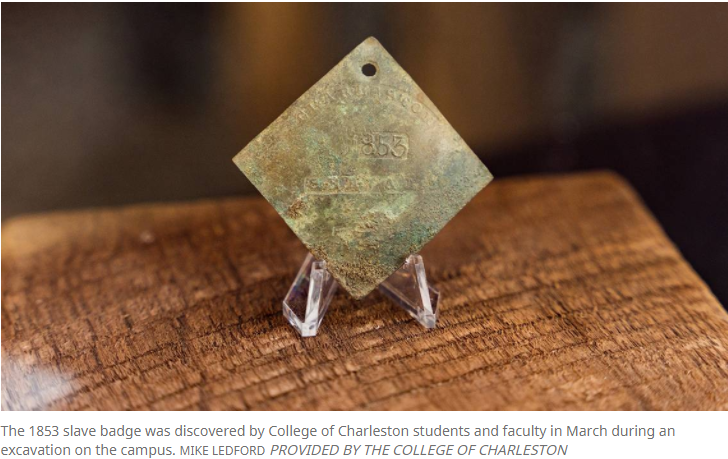CHARLESTON, S.C. — A small yet profound object tied to slavery and unearthed by a team of researchers and students at the College of Charleston this spring has been named one of the top discoveries of the year by Archaeology Magazine.
Found on the site of a 19th-century kitchen, the slave badge, also known as a slave tag, is a diamond-shaped medallion that acted as a work permit in Charleston’s city limits. It allowed enslaved people to be hired out for part-time work in the urban city center by their master to perform specific jobs, like mechanic, porter and fisherman. The slave badge, which was discovered on what is now the College of Charleston campus, was issued in 1853 to an unknown servant.
The person who wore the small metal badge, most likely around their own neck, lived in a time when their identity — and the identity of other enslaved African Americans — was stamped into a piece of copper and reduced to their occupation and badge number.
Theirs was 731.
The badge itself is a rare fragment of history, and its archaeological discovery is as noteworthy as fossilized footprints found in New Mexico and an ancient Egyptian city discovered beneath the sands after thousands of years, according to the editors of Archaeology Magazine. The list of top 10 discoveries made in 2021 will appear in the magazine’s January/February 2022 issue, which hits newsstands this week.
“We felt the tag had to be included because it’s a reminder of an individual who may otherwise have been lost to time and to the dehumanizing system of enslavement,” said Marley Brown, associate editor of Archaeology Magazine. Brown continued, “What’s more, the fact that the College of Charleston team recovered the object from its archaeological context provides a fantastic opportunity to learn more about the person who may once have worn it — a real gift considering many of these tags have no provenance.”
Its discovery was also a bit of a surprise.
The reason there was ever an excavation site at 63½ Coming St. was because there were plans to build a solar pavilion there. Because the school received federal dollars from the U.S. Department of Energy through the S.C. Department of Energy to complete the project, it meant the site required a cultural resource survey before construction could begin.
The digging began in February, and in March, while sifting through the dirt below, the slave badge surfaced.
Other artifacts were found at the site, too, like pottery, animal bones and an old ceramic soda bottle.
But the slave badge was an explicit reminder of slavery, America’s original sin.
“You felt the evil,” said Jim Newhard, a classics professor, landscape archaeologist and director of the college’s Center for Historical Landscapes. “It redoubled in my mind that not only was this artifact an expression of enslavement, so were the other objects we were recovering.”
Grant Gilmore, an associate professor and Addlestone Chair in Historic Preservation, told the magazine that most slave badges, including those held by private collectors, have no origin story beyond what is listed on the badge itself.
That this badge was found in a specific Charleston kitchen could provide new clues to discover more about the person assigned that badge. Gilmore told the publication that an enslaved person living in that house “may have discarded the tag in the hearth or someone on loan from across town may have lost it one day.”
The nearly 4-centimeter square slave badge is also a physical reminder of how urban slavery worked in Charleston, said Bernard Powers, director of the college’s Center for the Study of Slavery in Charleston.
“This discovery confirms the idea that Black labor was integrally involved in shaping the contours of the land, erecting the city’s buildings and providing the human connections that made Charleston the vital center of production and exchange it became and remains today,” Powers said in a statement after the badge was found earlier this year.
While other Southern cities had similar hired labor arrangements for enslaved workers, Charleston is the only one that produced such tags or badges, Gillmore told the magazine.
Slave badges were dated and were issued annually and became a source of tax revenue for the city. Costs for tags in 1865 ranged from $10 to $35.
The day the slave badge from 1853 was discovered, Newhard said he temporarily paused the work at the site to help students understand the artifact and better recognize the site as a whole.
He said he wanted them to see the importance and value of the work they were doing.
“We knew we were excavating a space inhabited and used by enslaved people. Intellectually, everything that we were collecting was possessed or used by those people,” Newhard said. “The tag, however, puts an agent to that scene.”
Even though the badge may have allowed an enslaved person to move more freely in the urban landscape and earn a small income for his or her family, Newhard said the badge was still an object worn as a mark of enslavement.
–thestate.com



